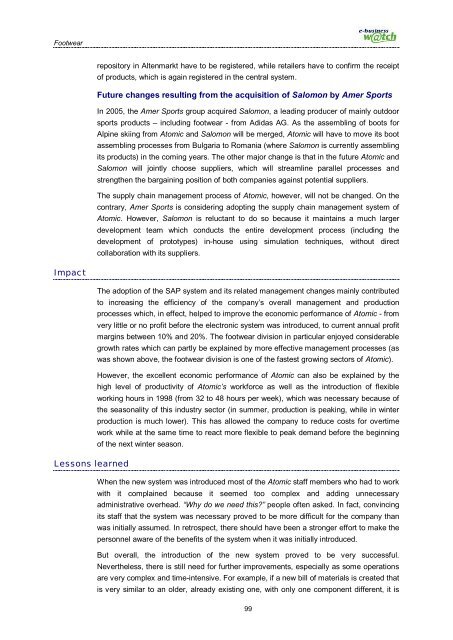Footwear Industry Footwear Industry - empirica
Footwear Industry Footwear Industry - empirica
Footwear Industry Footwear Industry - empirica
Create successful ePaper yourself
Turn your PDF publications into a flip-book with our unique Google optimized e-Paper software.
<strong>Footwear</strong><br />
repository in Altenmarkt have to be registered, while retailers have to confirm the receipt<br />
of products, which is again registered in the central system.<br />
Future changes resulting from the acquisition of Salomon by Amer Sports<br />
In 2005, the Amer Sports group acquired Salomon, a leading producer of mainly outdoor<br />
sports products – including footwear - from Adidas AG. As the assembling of boots for<br />
Alpine skiing from Atomic and Salomon will be merged, Atomic will have to move its boot<br />
assembling processes from Bulgaria to Romania (where Salomon is currently assembling<br />
its products) in the coming years. The other major change is that in the future Atomic and<br />
Salomon will jointly choose suppliers, which will streamline parallel processes and<br />
strengthen the bargaining position of both companies against potential suppliers.<br />
The supply chain management process of Atomic, however, will not be changed. On the<br />
contrary, Amer Sports is considering adopting the supply chain management system of<br />
Atomic. However, Salomon is reluctant to do so because it maintains a much larger<br />
development team which conducts the entire development process (including the<br />
development of prototypes) in-house using simulation techniques, without direct<br />
collaboration with its suppliers.<br />
Impact<br />
The adoption of the SAP system and its related management changes mainly contributed<br />
to increasing the efficiency of the company’s overall management and production<br />
processes which, in effect, helped to improve the economic performance of Atomic - from<br />
very little or no profit before the electronic system was introduced, to current annual profit<br />
margins between 10% and 20%. The footwear division in particular enjoyed considerable<br />
growth rates which can partly be explained by more effective management processes (as<br />
was shown above, the footwear division is one of the fastest growing sectors of Atomic).<br />
However, the excellent economic performance of Atomic can also be explained by the<br />
high level of productivity of Atomic’s workforce as well as the introduction of flexible<br />
working hours in 1998 (from 32 to 48 hours per week), which was necessary because of<br />
the seasonality of this industry sector (in summer, production is peaking, while in winter<br />
production is much lower). This has allowed the company to reduce costs for overtime<br />
work while at the same time to react more flexible to peak demand before the beginning<br />
of the next winter season.<br />
Lessons learned<br />
When the new system was introduced most of the Atomic staff members who had to work<br />
with it complained because it seemed too complex and adding unnecessary<br />
administrative overhead. “Why do we need this” people often asked. In fact, convincing<br />
its staff that the system was necessary proved to be more difficult for the company than<br />
was initially assumed. In retrospect, there should have been a stronger effort to make the<br />
personnel aware of the benefits of the system when it was initially introduced.<br />
But overall, the introduction of the new system proved to be very successful.<br />
Nevertheless, there is still need for further improvements, especially as some operations<br />
are very complex and time-intensive. For example, if a new bill of materials is created that<br />
is very similar to an older, already existing one, with only one component different, it is<br />
99

















